
Back in the summer of 2021, I read the Rijksmuseum, Amsterdam, were planning the biggest-ever single collection of Vermeer’s paintings for a Spring 2023 retrospective.
Johannes Vermeer (1632 -1675) is one of the great 17th-century Dutch masters, best known for his tranquil, contemplative scenes depicting everyday life.
February saw the opening of the exhibition, and last week we were lucky enough to experience the show!
What I love about Vermeer’s paintings is how he captures the sense of light fall; it feels like there’s a natural volume. He uses different paint handling to express a different quality.
From subtle gradations in the shadows as light streams through a window and drops away. To sunlight falling onto an object so convincingly, if you put your hand in the painting, it would be warm.
Not only did he capture the light, he told a story.

Girl with the Red Hat, Johannes Vermeer c.1665
Many of the paintings have a modern, minimalist feel, and it doesn’t seem possible that they were painted 400 yrs ago. Henri Cartier-Bresson often refers to the perfect moment to capture a photograph as the ‘Decisive Moment’. That’s when the image has the most tension in telling the story of the scene, when everything comes together.
And that’s what Vermeer is so good at.
He uses props, fabric, patterns and colour relationships. He builds a narrative to make viewers feel like they’re entering his world.
A housemaid engrossed in a serene moment of domesticity.
Fashionably dressed women playing music or have just stopped to take a sip of wine, and men dashing in, their elegant cloaks still draped over their shoulders. One of them turns to the onlooker, connecting us from the outside to the inside.
Although Vermeer’s body of work is relatively small, his paintings are often among the most prized treasures in museum collections. They are rarely lent out for exhibitions, so the opportunity to see 28 of Vermeer’s known 37 works from museums and private collections worldwide was incredible.
“To call it rare is to undersell it severely. It took seven years of diplomacy to organize.”
New York Times
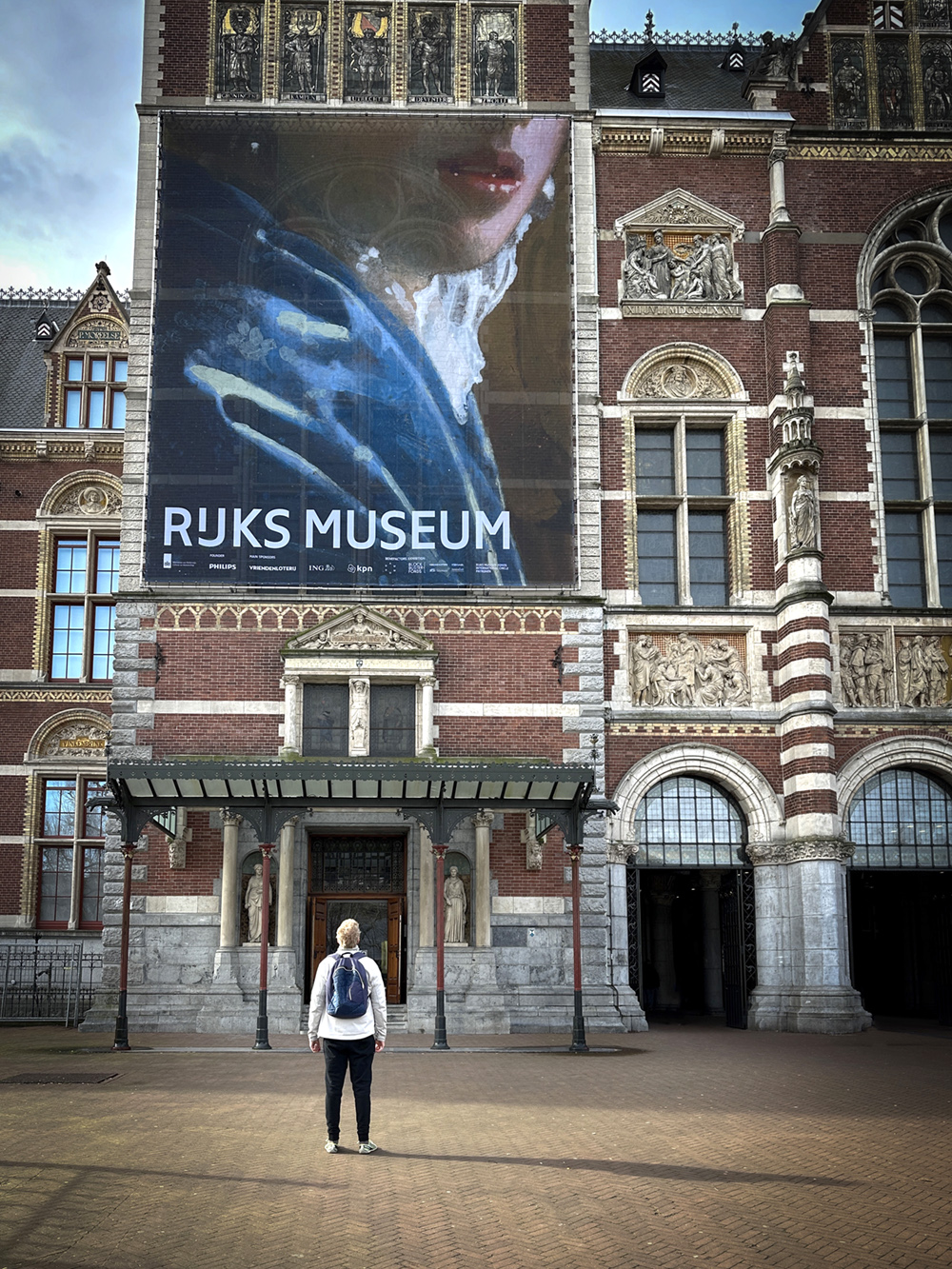
As we approached the Rijksmuseum, its awesome Gothic and Renaissance facade towered above us. Its impressive red brickwork leads you into a glassed roof modern atrium.
Daylight pours into an open, clean space with polished stone floors, and anticipation was in the air amongst the sea of queuing ticket holders.

The Early Years

Johannes Vermeer was born, raised, and died in Delft. He grew up surrounded by the paintings in his father’s art business. He made three paintings of Delft, and only two survived.

View of Delft, Johannes Vermeer c.1660 – 1661
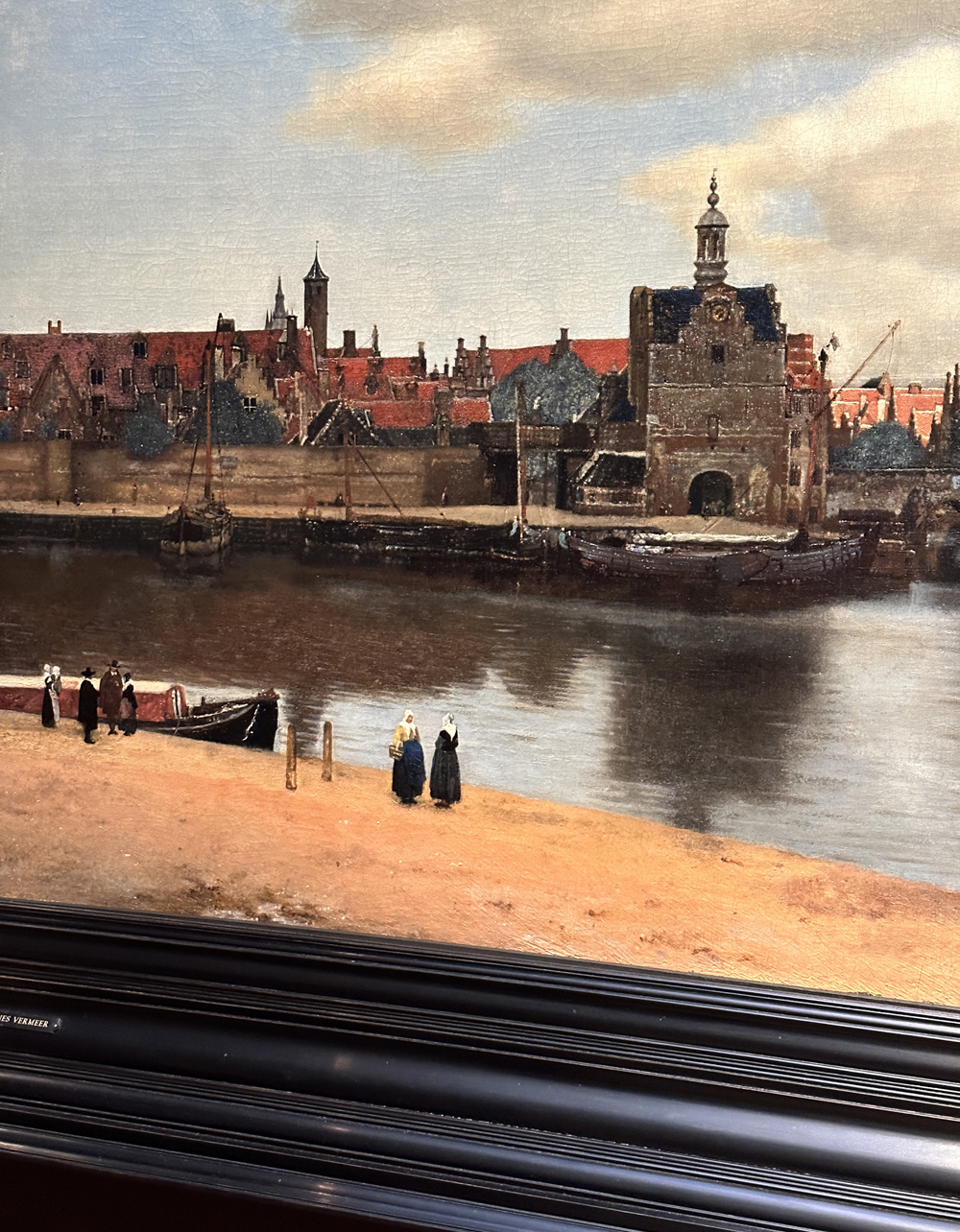
View of Delft, Johannes Vermeer c.1660 – 1661 (Detail)
In the View of Delft, he doesn’t emphasize the most important buildings in the city but leads our eye into the distance by means of effects of light and dark, perspective, colour and texture.

Flying into Amsterdam
Whenever I fly into the Netherlands, the cloud formations and sky have such a painterly quality. The clouds seem to hang there, waiting to be painted.
Even with the imposing layers of clouds and detailed roofline, the element that brings us into the scene is the couple talking at the front of the composition.
This chance meeting on a morning stroll, discussing the day’s gossip feels somehow comforting. Notice how Vermeer placed the figures within a high-contrast area of the water. This helps to focus our eyes. He does the same in The Little Street.
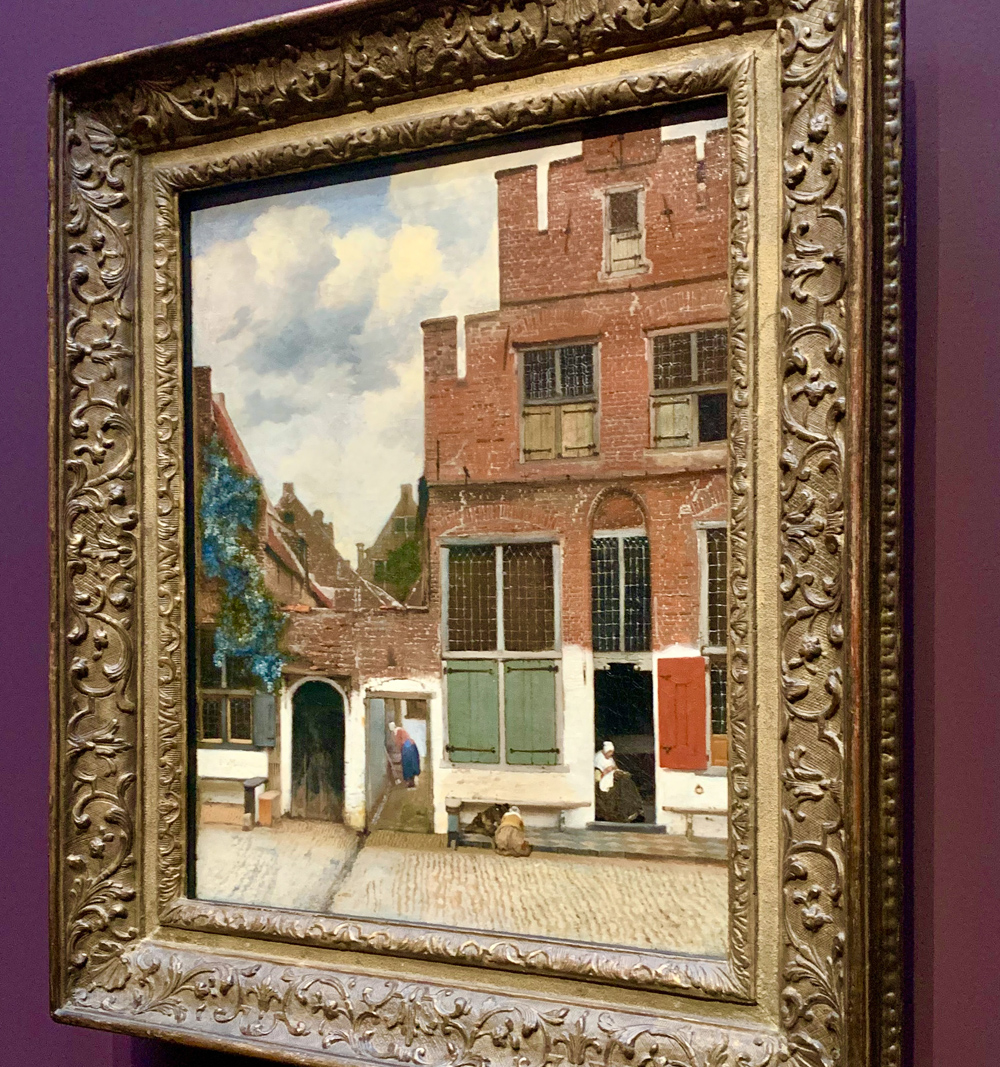
The Little Street, Johannes Vermeer, 1657–1658
I love The Little Street. I’d seen it before, but it was like seeing an old friend. The red brick houses sit against the bright cloudy sky, and the figures add a sense of everyday calm.
I almost feel like I can hear the noise of cobbles being swept and children playing and it’s fascinating how the brickwork and wooden shutters possess their own distinct physicality.

Using the strongest tonal contrast of the seated women, we notice her first. Then the women in the alley. Even though more colourful, the tonal range is much more compressed. Finally, we see the children playing in the centre on the front doorstep.

The Little Street, Johannes Vermeer, 1657–1658 (Detail)
Large-scale Religious scenes
By his early twenties, Vermeer had just established himself as a painter and recently married; he painted religious and mythological subjects.

Christ in the House of Mary and Martha, Johannes Vermeer, c.1655
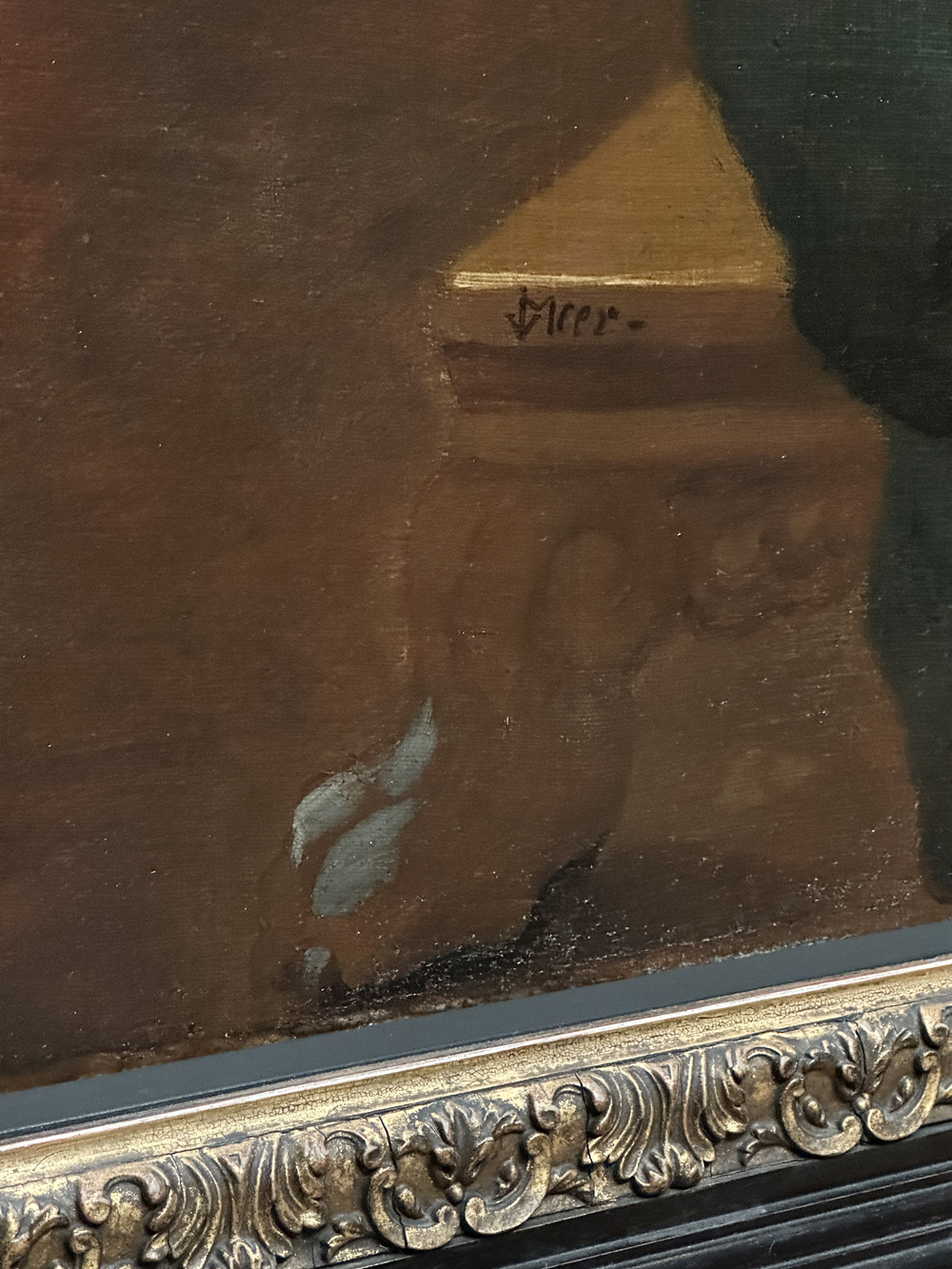
Christ in the House of Mary and Martha, Johannes Vermeer, c.1655 (Detail)
Looking at the details on this chair leg, you can see the underpainting and how Vermeer constructed the piece. Painting the entire canvas in a warm earth colour establishes tonal values.

Saint Praxedis, Johannes Vermeer, c.1655 (Detail)
Saint Praxedis is a copy after a picture of the same subject by a contemporary Italian master Felice Ficherelli, and it may be Vermeer’s earliest surviving work, dating early 1655. If you look at her face, you can also see evidence of the next stage of the painting, adding a grisaille element on top of the warm underpainting.
First Interiors
Around 1658, Vermeer’s scale and size of paintings changed. It’s interesting to look at Vermeer’s contemporaries to see how your environment can shape your artistic development.
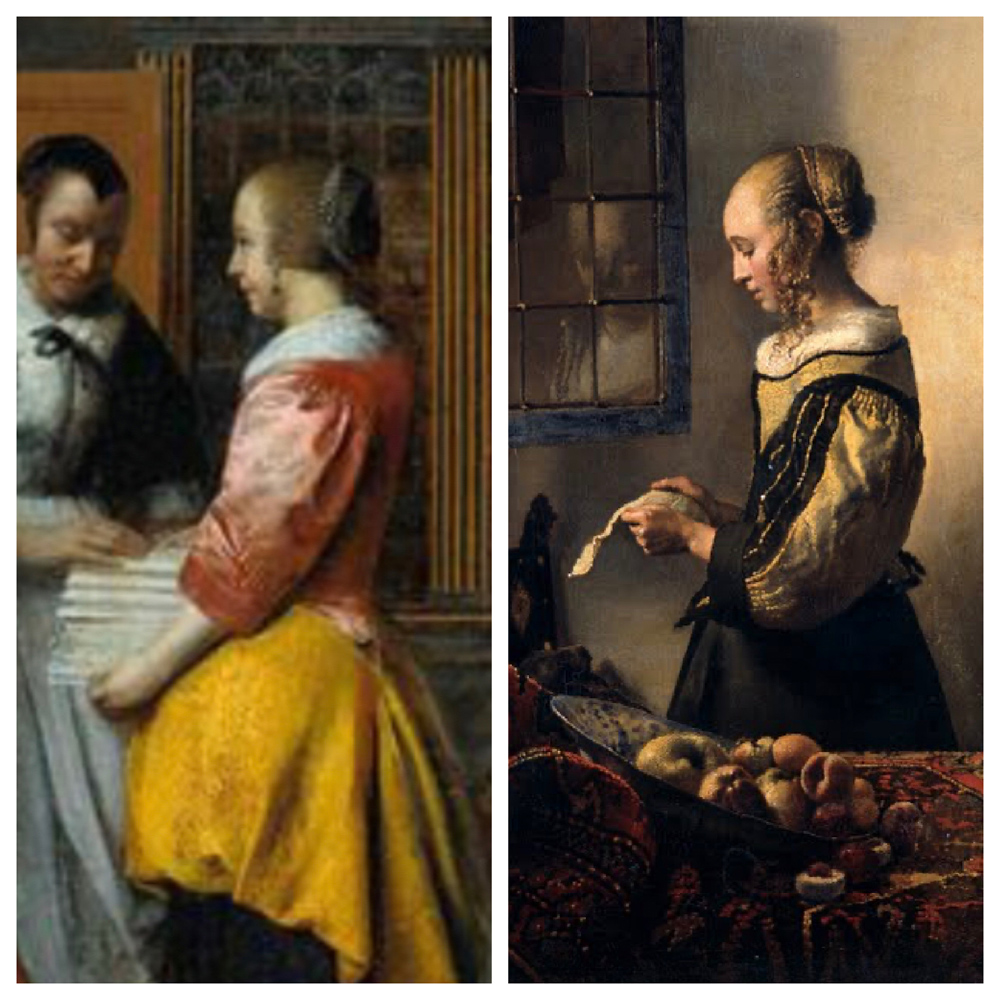
Left: Pieter de Hooch, Interior with Women beside a Linen Cupboard,1663
Right: Johannes Vermee, Girl Reading a Letter at an Open Window, 1657–1659
Painter Pieter de Hooch also lived in Delft.
Above is a detail of one of de Hooch’s paintings that is also on display in the main gallery of the Rijksmuseum. There is a similarity in pose and dress of both of the figures.

Pieter de Hooch, The Courtyard of a House in Delft, 1658
Above is The Courtyard of a House in Delft (on display at the National Gallery in London) The figures on the right have the highest contrast. The figure in the doorway is in lower contrast but with muted colour. There is a small child, who also wears a yellow ochre dress.
Little Streets is dated 1657–1658, de Hooch 1658. You can see compositions and poses influencing each other. Pieter de Hooch became a member of the painters’ guild of Saint Luke in 1655 (two years after Vermeer).
There were also other artists like Jacob Vrel who had painted similar scenes of domestic interiors before Vermeer, Mauritshuis Museum in the Hague (where the Girl with the Pearl Earring usually resides) has a Vrel exhibition on until May 2023.
Vermeer’s Tutors
There is little evidence of who Vermeer studied under. But one notable artist also lived in Delft around the same time.
Carel Fabritius was a Dutch painter who studied with Rembrandt (Yeah Rembrandt!) and worked in his studio.
Fabritius tragically died at the early age on 32 when an explosion occurred in a gunpowder warehouse in Delft. It’s thought there is still shrapnel remains in one of his most famous surviving paintings.

The Goldfinch, Carel Fabritius, 1654.
The Goldfinch was completed in 1654 and is now housed in the Mauritshuis museum in The Hague.
Just look at how Fabritius painted shadows, with a softened colour palette, and muted tones. They have that luminous layered quality evident in so many of Vermeer’s paintings.

There is little documentation of the exact location of Vermeer’s studios. Some think he painted in clients’ houses, while others believe most likely that he had a studio in his Mother-in-law’s house. And maybe another on the first floor of his father’s inn.
Central to the success of the interior scenes would have been a location where he could create sets and paint for prolonged periods. His father, Reijnier Janszoon, was a bit of an entrepreneur. Silk weaver, an art dealer (registered with the Guild of St Luke) and in 1641, took on a large mortgage to buy an Inn on the market square in Delft. This was a place with roaring fires for the guests and rooms that could be used for gathering places for other artists.
Nice big windows, inspiration from everchanging artworks and a place for like-minded artists to meet (and free beer on tap!)

The Milkmaid, Johannes Vermeer, c. 1657–1658

The Milkmaid, Johannes Vermeer, c. 1657–1658 (Detail)
In The Milkmaid, he determined the vanishing point with a pin just above the woman’s right arm (the pinprick hole is still there).
There is evidence of many overpainted parts; Vermeer painted over a jug rack he had initially placed on the wall just behind her head. He also overpainted a large basket, replacing it with Delft blue tiles and a small foot warmer with a basin of coals.
Above all, the light dominates the room, playing and reflecting on every object. The bread and basket on the table comprise hundreds of dots of light. It feels like you could move within the space, there’s a volumetric light handling all within this one scene
The everyday activity is simple but concentrated; only the stream of milk seems to move. Vermeer lets us into his quiet world.

Girl Reading a Letter by an Open Window, Johannes Vermeer, 1659
In the painting above, the green curtain acts as a composition device, giving us a clear view of the woman reading whilst the large painting of Cupid looks back at us.
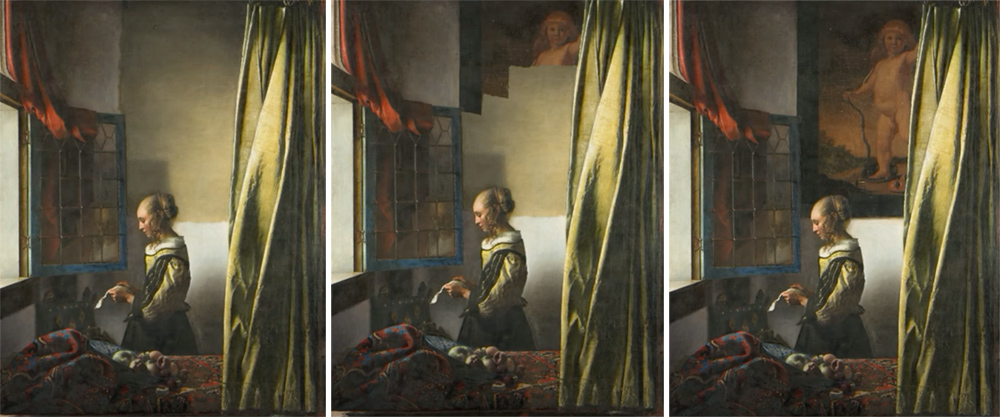
Left: Before 2019 restoration, Right: Painting of Cupid revealed
Cupid remained concealed beneath a layer of white paint until 2019. During the painting’s recent restoration, it became evident that the whitewash wasn’t by Vermeer, but by someone else at a later date. The removal of the overpainting shows how the it fits into Vermeer’s early religious work.
It could also be a clue into the letter’s subject, with Cupid being the God of Love.

Woman Writing a Letter with her Maid, Johannes Vermeer, 1670-1671
You can see here the same compositional devices again. A curtain to bring us into the scene, a large painting adds tonal contrast and can add layers to the narrative.
The perspective lines of the tiles, table and chairs, create a convincing spatial illusion. Vermeer placed the figures in the foreground, allowing us to approach them up close, giving a greater sense of intimacy between the viewer and the scene.
There is a remarkable purity of light that seems even more impressive when you consider that Vermeer was painting under only a natural light source in a time known as ‘the little ice age’ in Northern Europe, where there was minimal sunshine in the Winter months.
I often find myself engrossed in the intricacies of a window pane or his rendering of crumbling plaster and brickwork.
A Direct Gaze

Girl with the Red Hat, Johannes Vermeer c. 1665 Girl with a Flute, Johannes Vermeer c. 1669
Between 1664 and 1667, Vermeer produced a small group of paintings of women gazing at the viewer. They look straight out of the canvas at us.
The Girl with the Red Hat is a fabulous painting! Much smaller than I had imagined. It’s only 23 cm x 18 cm (9 x 7 inch). The red appears more intense, and the figure has much more presence than in reproductions I’d previously seen.
While based on studies of real women, they are not portraits. Vermeer was actually depicting tronies, which were very popular in his time.
Tronies means “face” in 17th-century Dutch. It refers to a group of paintings that portray an anonymous sitter. They presented the artist with a unique opportunity to experiment.
Vividly painted character heads and fantasy portraits of figures in fictional costumes are a bit like painting someone dressed up from a theatre production. In these works, painters explored the human face and facial expressions.

Girl with a Pearl Earring, Johannes Vermeer, 1665
Turning their head and looking over their shoulder, these women engage with us very directly. Vermeer strove for even greater simplicity. All attention is focused on the young woman and her gaze.
Now faced with the most famous of Vermeer’s portraits, The Girl with a Pearl Earring, the exhibition feels complete. To experience an artwork so infamous surrounded by all the other paintings created in his life feels like a privilege that Vermeer himself would have never experienced.
Vermeer dressed the sitter in Oriental headwear that wasn’t common at the time.
If you look at the features in comparison to the two previous paintings, the slight openness of the mouth is very similar. He creates a strong spotlight effect by having headwear that doesn’t cast a shadow, with catch lights in the eye and the sparkling reflection on the pearl earring.
The Storytelling Power of Letters

Woman in Blue Reading a Letter, Johannes Vermeer, c 1663
Letters are often the subject in Vermeer’s work; they act as a visual aid to add drama. Who is the letter from? What have they discovered? How will their life now change?
I love the composition of this piece and how the spaces around the figure balance within the scene. And when you simplify the painting, the story of the scene is still apparent.
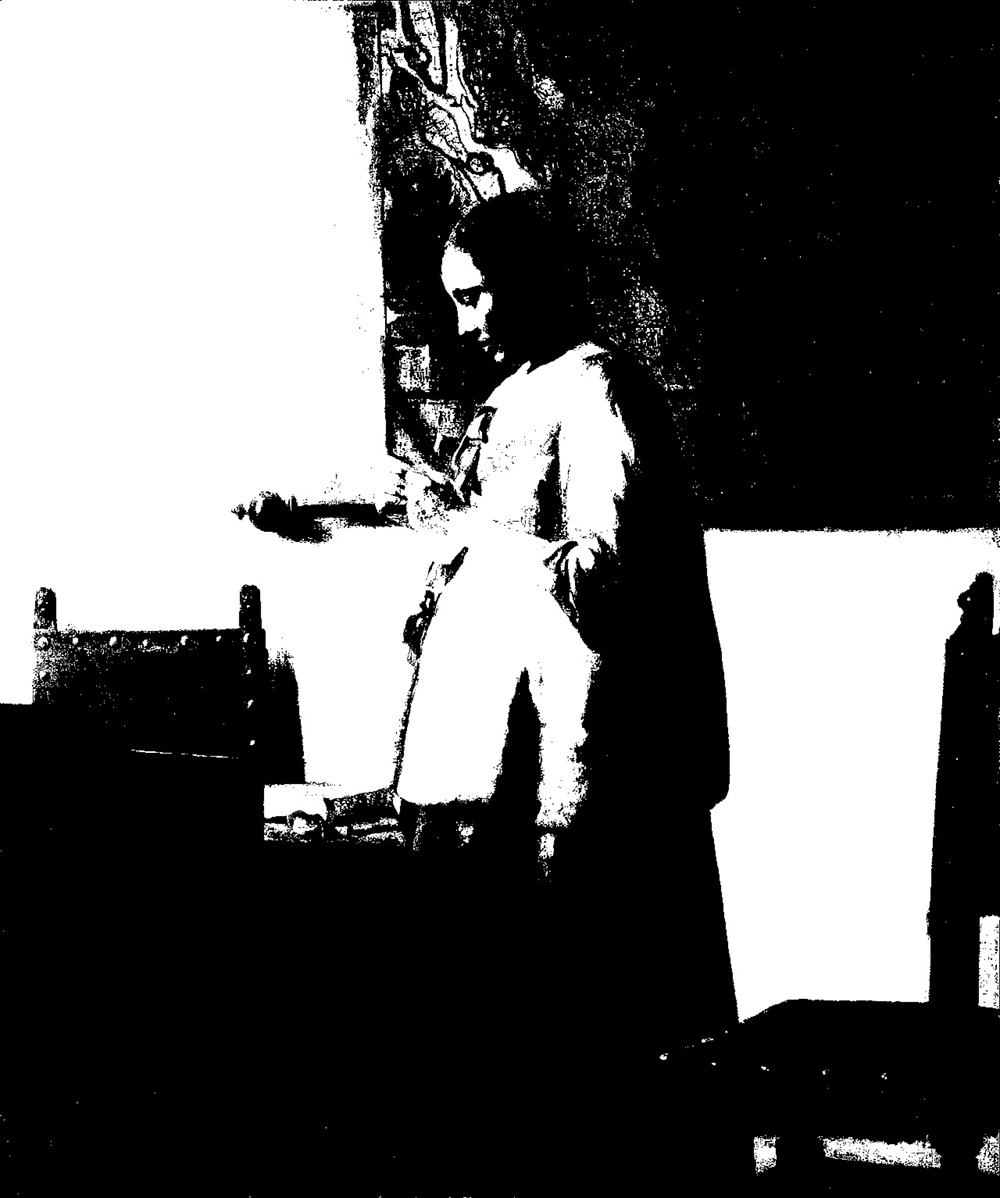
Notan version to illustrate the strong graphic design of the painting.

Mistress and Maid, Johannes Vermeer, c 1666-1667
In Mistress and Maid, a woman sitting at her writing table is surprised by the letter brought in by the maid. Maids could deliver letters within the city, and the outside world comes in again.

Woman Holding a Balance, Johannes Vermeer, c 1662-1665

Woman Holding a Balance, Johannes Vermeer, c 1662-1665 (Detail)
Vermeer painted a small group of works around 1662-1664 capturing women engrossed in a hushed moment of contemplation, standing at a table with various objects.
In Woman Holding a Balance, a lady stands at a table with precious jewels. In Vermeer’s time, this was seen negatively because it was vain and focused on appearances.
She holds a pair of scales to determine their monetary value. Hanging behind her is a painting of the ‘Last Judgment from the Bible, making it clear that she too will be ‘weighed’ or judged one day.
View of the world

This is one of Vermeer’s few works in which a man is a central figure.
The Geographer studies the maps on the table, a pair of dividers in his hand. Although his gaze has drifted off into the distance. A terrestrial globe rests on top of the cabinet behind him.
The light falls directly on the geographer’s papers and forehead, emphasizing the scientist’s focus on the outside world and we are drawn into the seclusion of the study.

The Geographer, Johannes Vermeer, ca. 1668-1669
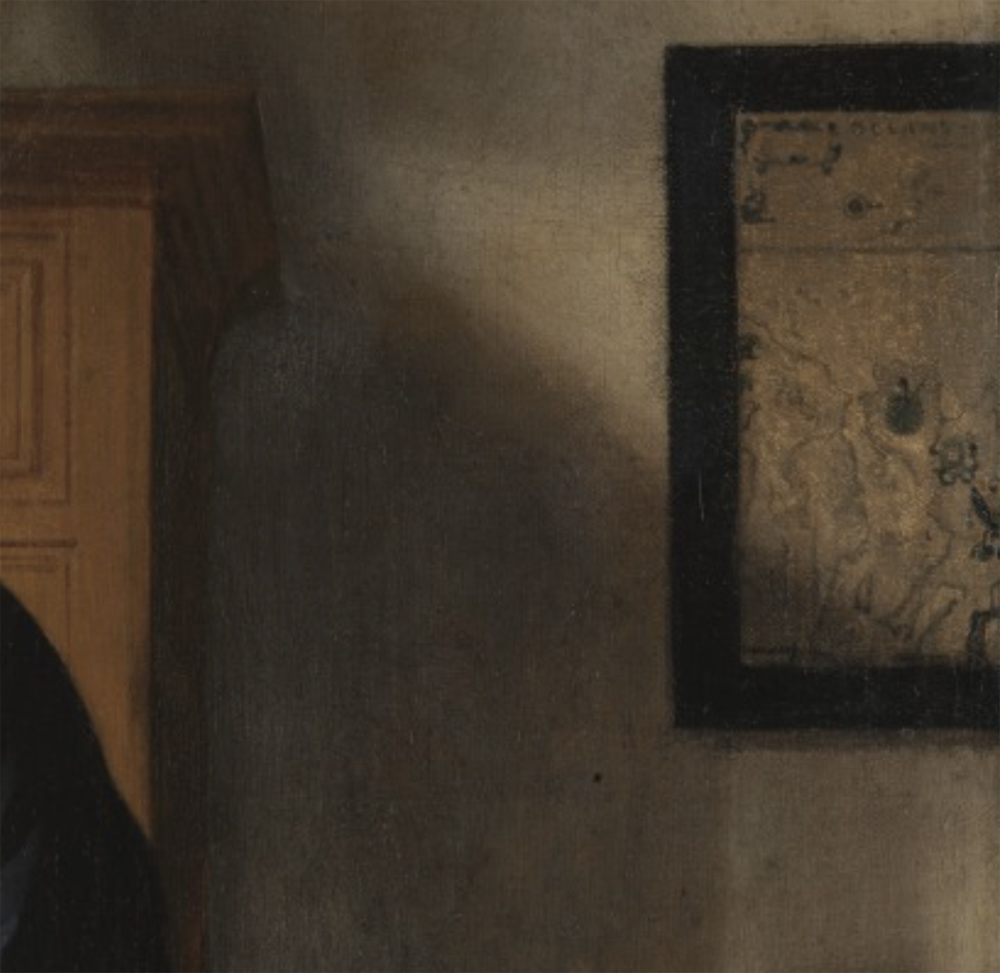
The Geographer, Johannes Vermeer, ca. 1668-1669 (Detail)
There is a subtle rendering of the light fall, and the textures on the back wall.

The Astronomer, Johannes Vermeer, c 1668-1669
The Geographer is one of two paintings conceived as a pair. This is known as ‘A Pendant” The other, The Astronomer (Louvre, Paris), features a scholar studying a celestial globe.
On an Obscure note

Vermeer’s highly detailed renderings of interiors, in a style that had changed from his earlier works, led many historians to believe that he used optics.
While some believe that Vermeer must have had access to and utilized lenses to create his work, many others remain convinced that he could achieve his results without using any man-made tools.
David Hockney’s book ‘Secret Knowledge‘ is a fascinating look into Hockney’s thoughts on the use of optical devices throughout art history. Philip Steadman’s ‘Vermeer’s Camera‘ also looks in great detail at room reconstructions and the possible uses of a Camera Obscura.
But perhaps the most convincing example is from the 2013 documentary ‘Tim’s Vermeer’. Inventor Tim Jenison goes to extreme lengths in room reconstruction, time and dedication to create his own version of Vermeer’s music lesson.
At one point in creating his painting, Tim discovers something that has gone unnoticed for years. I’ll let you watch the documentary to decide!
Leeuwenhoek the Lensmaker
Another Delft resident at the time of Vermmer was Antonie van Leeuwenhoek.
Van Leeuwenhoek trained as a draper and then was Chamberlain to the Sheriff of Delft. But his real passion was lenses. In his spare time, he was dedicated to grinding lenses. He was a pioneer in the field of microscopy.
Van Leeuwenhoek was the first person to observe and describe single-celled organisms and a wide range of other microscopic phenomena, such as blood cells and microscopic worms.
So with his skills in lensmaking and the possibility of meeting Vermeer at his father’s Inn, it’s not a huge jump to think they may have known each other. On Vermeer’s death, Van Leeuwenhoek was the executor of his Will. This may have been part of his role as chamberlain to the sheriff, or they just might have been great friends.
“Van Leewenhoek, the great microscopist and lensmaker, was a neighbour of his and executor of his will” – David Hockney, Secret Knowledge

In the exhibition, you were allowed to take photographs, so it was ironic that Vermeer’s paintings, which have been put under the microscope to discover if he used optics, were viewed by visitors through their iPhone camera lens.
Life-imitating art!

There’s no better way to end an exhibition than with a comforting aroma of baked apple and cinnamon, especially with a generous serving of whipped cream, and a ‘Vermeer Beer’ from the Rijksmuseum cafe.
The exhibition runs until 4 June 2023
You Might Also Enjoy these other exhibition reviews:
Inside the Artist Studio: Rembrandt’s Studio
Singer Sargent and Friends
Discovering Zorn
Capturing Sunlight with Sorolla
Discovering Velasquez
Monet & Architecture
How to Paint, Sleep (and Nearly Die) like Cezanne
There are also some more photos of food finds in Amsterdam on Instagram! Instagram @willkempartschool




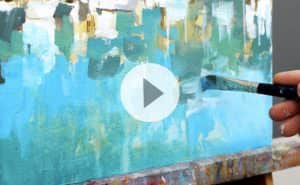

Thank you for your impressions and reflections on your recent to this fabulous Vermeer Exhibition.
I thought I had seen most of his famous paintings but you have certainly inspired me to find some of his other wonderful creative works as you say unbelievably completed 400 years ago. It is marvellous how he captures light in both his interior and external scenes. There is a certain uniqueness in the quality and detail of all of his paintings.
My pleasure Keith, so pleased you enjoyed it. And glad you’re looking forward to exploring more of Vermeer’s work.
Will
Simply stunning and breathtaking and what a lovely way to start my Sunday morning! Thanks for sharing your trip, Will, and I hope Vermeer will one day visit the shores of America.
cheers,
Grace
Thanks Grace, so pleased you enjoyed it.
Will
Thank you this was amazing reading for my Sunday morning!
So nice to hear Luann.
Thank you so much Will,
Pure happiness reading your article and enjoying your wonderful photos of all the paintings, just gorgeous, Julia x
Thanks very much Julia.
I delighted in seeing these paintings together. And loved being able to see a bit through your sensitive and knowledgeable eyes. The How of seeing and appreciating what moves you. Thank you. Particularly for your generosity in sharing your experience of this glorious painter.
Selina Sweet
My absolute pleasure Selina, thanks for your kind comments.
Will
Wow Will! I can tell from your writing that this exhibit really resonated with you. Thank you so much for sharing everything and going into such exquisite detail. It almost makes up me for not being able to go and see it for myself.
Thanks James, much appreciated, hope it gave an insight into the show.
Thank you so much for taking the time to share your experience (and more) at the Vermeer show. I enjoyed it very much. Your photos are great in not only to see the beauty of the paintings but also to show scale.
Thanks Tomoko, yes the scale of the paintings can be a real surprise, so pleased you enjoyed the photos.
Will
Thank you for taking us with you! I cannot see the exhibition, so this was amazing to see through your eyes (lenses).
My pleasure Elizabeth, glad you enjoyed it.
So pleased you are able to share your wonderful experience of Vermeer’s work.
Delighted that I have been able to visit the Rijks Museum, but not recently.
An amazing place. You should also have been a poet as well as a wonderful artist and tutor the way you have been able to express your visit and make me feel as though I am there with you.
Many of Vermeer’s paintings would have you believe that he enjoyed working in a tight space in a corner of a room. By the way, did you eat all that wonderful piece of cake and sup that beer all on your own. Gulp! It is great that you share your visits to so many places. Always enjoyable. Thank you Will.
Thanks for your kind words Charles, you do have to keep up your energy after a long exhibition!
Wonderful review, thank you.
Cheers Barbara.
IT IS LIKE GOING TO ANOTHER WORLD. THE SUBTLE COLORS HE USED WERE AMAZING. SUCH DETAIL. I COULD LOOK AT THESE ALL DAY LONG. JUST SO BEAUTIFUL
Thanks Cheryl.
How wonderful that you were able to experience this exhibit. Thank you for sharing, and for your insights & observations!
My pleasure Mary.
Thank you so much, Will, for sharing your experience with us. Your photos show so much more and are more vibrant than those in books. I hadn’t realised that so many of his paintings are so small! How on earth he managed to capture so much detail……
So pleased you enjoyed seeing them Brenda, glad it helped bring the exhibition to life.
Will
I can see how you have enjoyed this exhibition. I was lucky to see some paintings of Vermeer back in 2002 in Rijksmuseum. The milkmaid is spectacular. The light it emanes seems there is a light on its back. Vermeer is one of my favourite painters. Some years ago I painted the Girl with Pearl earring as a friend asked me to do so. He wanted me to sell it but I refused. So the painting stays in my house until today. I loved this article so much that I printed it all. Heartful thanks dear Will Kemp. Isaura Xavier de Campos
Oh wow, thanks so much Isaura, glad you kept your painting and enjoy it to this day.
Will
So enjoyable to see it through you. Thank you for sharing!
My pleasure Astyn.
Thank you for bringing the exhibition to us and you reflections from across the ‘Pond’ ! I look forward to your musings and learn so much. You renew my eye, inspire creative journeys and exploration. Still working on the drawing class bit by bit as I fight my inner critic / getting my Censor quiet is a job. Appreciate your website So Much!
Hey Diana,
Thank you very much for your kind words! I’m glad to hear that the article has been interesting and inspiring for you. I’m happy to hear that my website has been helpful to you.
I think it’s great that you’re taking the time to work on your drawing skills and overcome your inner critic, I’m sure you’ll find it to be incredibly rewarding in the end.
Cheers,
Will
I really enjoyed your wonderful review of the Vermeer exhibition and your photos of his paintings! I’m surprised at their small size, but I can imagine the detail of his work took time and a smaller piece was the result. Thank you for doing this, I loved it all!
So pleased you enjoyed the review Joan.
It is so generous of you to share these insights and photos Will! I thoroughly loved it and have already ordered more books on Vermeer because he has fascinated me since childhood.
Great stuff Bethany, really hope you enjoy the books.
Will
Hello Will .
Thanks for the great photos from the Vermeer exhibition . A friend of mine also travelled to Amsterdam to enjoy this rare experience and sent many photos back to me . From his and your account it would seem to be a thrilling show .
Very best wishes ,
Patrick Halloran .
Sounds like a great double combo Patrick!
Will you must have been on cloud 9 standing in front of these paintings. I envy you. Wish I was there.
Thanks Mike, yes it was a great experience.
What a treat to read. Your insights are wonderful. How lucky you are to lay eyes on all these and how lucky for us you’ve shared.
Cheers Steve, so pleased you enjoyed it.
This has been just wonderful. Thank you so much for sharing your experience with us. Liz
My pleasure Liz.
Will, I have an overwhelming desire to paint you looking at the Girl with the Pearl Earring in the 1st pic. Asking first for permission and if granted, followed with a disclaimer that it will look like shite. Just setting that bar up for both of us, lol
Ha, ha, go for it Tricia!
This is JUST amazing, getting to see this through your eyes is such a privilege. Thank so much for allowing us to be there vicariously!
My absolute pleasure Norma, thanks so much for reading.
Will
Avsolutely breathtaking and gorgeous, Will!
Thank you so very much!!
God bless, C-Marie
Cheers C-Marie.
Thank you so much for sharing this wonderful exhibition and all your observations and thoughts and letting us readers see it all through your eyes. I do not feel so sad about not being able to see it in person myself.
Ahh, that’s lovely to hear Ann-Kathrein.
Hi Will,
I enjoyed your recap and almost felt like I was there. Whether or not Vermeer used optics is unclear at this point, but I imagine if I lived during the Little Ice Age, day after day, year after year, I would be pretty darn tired of it, and what better way to escape the gloom than to immerse my thinking in vividness; texture, light, clarity of imagery. Therapy! Looks like it was a wonderful day. Thanks for sharing.
So true Laura, very well put.
Thank you so much for taking us the “tour” of Vermeer’s paintings with you. I thoroughly enjoyed your analysis of his paintings in the way he painted light and shadow.
Thanks Gail.
Will, what a wonderfully written observation of the world of Vermeer. I have been to Amsterdam (usually on my way to someplace else) a couple of times and it always has been on the day that the Rijksmuseum is closed! Thank you for not only walking me through the works of Vermeer with such insight and attention but for also letting me inside the Rijksmuseum.
I remember seeing “Tim’s Vermeer” when it first debuted. It was a fascinating look at the possibilities of Vermeer’s approach to his painting. It’s time to watch it again.
Thank you again, Will for your excellent writing and for bringing these beautiful works of art to those of us who can’t be there to see them face to face.
My pleasure Janice, thanks so much for your kind words. So pleased you enjoyed it.
Hi Will,
Thank you so much for sharing the paintings and giving your informative comments. It was the next best thing to being there!
Cheers Irene.
What a marvellous treat. Thank you for sharing this, Will. It truly was a delight to read your insights, so beautifully observed.
Thanks Helene, very much appreciated.
Hi Will, thank you so much for sharing your wonderful trip to us. I feel like I wanted to paint again.
Well that’s fabulous to hear Sandy, so pleased you’re feeling inspired.
This virtual tour was great, it felt like I was there looking at it all. Thanks for putting this together and posting it. This was a treat!
My pleasure Rose Ann.
Will, thank you for expressing your impressions of these gems. If one couldn’t go, at least one can experience the awe and the “ahhhh!” of being present.
Glad it helped bring the exhibition to life Cynthia.
Thank you for your kind and generous spirit in sharing this experience with us in such a way that I felt I was walking from piece to gorgeous piece. I’ve been enjoying your amazing class on Water Soluble Oils … you’re Little Street study is wonderful. Thanks again. This was a great Sunday night read.
Fab stuff Suzanne, glad you’ve been enjoying the WMO course. It gives you a whole new appreciation when you’re trying to paint even a small section of a Vermeer yourself, glad you’re enjoying the process.
Will
What a wonderful post – thank you! I am looking forward to seeing the exhibition when I travel from Canada in several weeks…
Brilliant stuff Richard, hope you have a wonderful trip to Amsterdam.
Thank you so much Will, for sharing this wonderful exhibition and your insights. Living in NZ I’m unlikely to ever see these amazing paintings so to be able to go round the Rijksmuseum with you was a great treat.
Then I watched Tim’s Vermeer. Thank you too for that recommendation. It was revelatory, both about Vermeer, and about Tim!
Your generosity in sharing your lessons and your art focussed travels is a gift beyond price.
Thank you so much for your kind words Kate. I’m thrilled to hear that you enjoyed the exhibition review and taking the time to watch “Tim’s Vermeer” and I’m glad you found it enlightening.
Wow, this was such an in-depth viewpoint of the whole exhibit and beyond. Thank you very much for taking the time to do this.
Glad you enjoyed it Jacque.
Thank you Will
Your article gives a fitting insight to such a masterful Artist and storyleller as Vermeer. Each painting gives us an unique opportunity to learn from his approach and that of his contemporaries. Vermeer clearly put a lot of thought into preparation of a subject before even picking up a brush. Also, he knew when to simplify the scene to ensure he achieved harmony across the painting so each element added to the story rather than taking away from it. Vermeer really was a wonderful artist. A master of technique and observation depicting subjects he thought fitting for his time or was commissioned to complete.
Thanks for your insights Paul.
Will. Thank you for bringing us all along to the museum. The writing is descriptive & educating. The photos brought us all right beside you, so beautiful..and I swear I could smell apples & cinnamon. Lovely
Thanks for your kind words Susan, so pleased you enjoyed the review and photos.
Really informative and written in such an easy style that makes it extremely interesting while imparting a lot of facts. The sign of a good teacher. Thank you.
That’s great to hear Hilary.
Thank you! So wonderful to get your impressions of this historic exhibit.
My pleasure Erica.
Thank you so much Will. I have taken a lot of time today to study the paintings and your observations! You have taught me so very much and I feel totally enchanted by this artist’s work and your knowledge!
Sue
My pleasure Sue, thank you for your kind words and have a wonderful day!
Will, I studied Vermeer in Art History many years ago. I so wanted to see the exhibition in
person, but your review was excellent and I feel you did an outstanding job!
Thank you so much,
Judee
So pleased it gave an insight into the show Judee, thanks so much.
Thank you, Will, for sharing this amazing experience with us! I enjoyed every minute of seeing these wonderful paintings and reading you comments on them. (I also want one of those pastries!)
Yes, the pastries were quite marvellous! glad you enjoyed the photos.
Thank you so much for sharing Will. I visited the Vermeer Exhibition that was shown at the National Gallery many moons ago, and your review brought back lovely memories, which you will hold forever. Hope the apple and cinnamon lived up to expectations ….
So pleased it brought back nice memories Sue, that’s lovely to hear.
Will
I agree with Kate , your generosity and knowledge are greatly appreciated.
Being from Vancouver Island it is unlikely that I will ever see these paintings in person. Thank you!
Thanks Dianne, you’re so welcome.
You are so lucky, Will. Thank you for sharing this, so much appreciated. I looked it up and they’re sold out. Wonder if they repeat this exhibit in the US.
Glad you enjoyed it Zai.
I’m from South Africa and had no way of getting to the exhibition,but thanks to you,you’ve made it possible.
I just loved your review and comments.
Brilliant.
Very grateful.
That’s very kind of you Avril.
hi Will, to add to your fine review, it might be nice for your students and followers to have a look at this website:
https://kamer.denieuwevermeer.nl/
You can find here an inter-active view of Vermeer’s studio. I am afraid there is no English translation but the pictures tell their own story. In the last couple of months Dutch TV station Max broadcasted a 6-part series “de nieuwe Vermeer”
Amateur and professional artists were invited to create artworks of 6 lost (or stolen) Vermeer paintings based on sometimes very little information f.e. the list of belongings after he passed away or records of sales dating back to the period when he was still alive.
When entering the website you can choose “de kamer van Vermeer” (his studio) It is inter-active so you can move through the chamber by simply moving your mouse.
Click on “starten”; when you click “verder” you can have a 360 view of the room and click on several items for further explanation (in Dutch)
In the back you can find an easel and beside it, on the floor, is an arrow that leads you into an exposition of all the finalists works (30 finalists/ works per show) Click on the works and they will be enlarged with accompanying text.
The amateur artists were allowed to use any material they liked. You will see painted canvasses but also works made out of driftwood, textiles, wool, Lego, glass, seashells etc etc.
All works had to be connected to Vemeer and certain details of his techniques and use of colors (f.e. the famous blue hues)
Whereas the professional painters had to create their own Vermeer in paint (acrylic or oil)
Amazing series and in case you are able to follow the Dutch language a must see!
Cheers from Holland, Bram
Fabulous Bram, thanks so much for sharing the interactive Vermeer studio!
Will
As soon as I heard about this exhibition , I knew you would be there to cover it for those of us who couldn’t be there.
Thank you, thank you for such beautiful photos and insights . They are so appreciated! I love having this at my fingertips.
Thanks again Will.
My pleasure Ann, glad you enjoyed the photos of the show.
Will
Thank you, Will. I wish I were able to travel to Amsterdam from the USA, to see this in person. But it brought me to tears going through the images and following your text . . . I’m not sure why, but perhaps something to do with my being a small child peering at the little pictures of reproductions of masters’ paintings in our school art books and how I felt then, trying to imagine the world they were painting, trying to enter it. I so appreciate your “tour” of the exhibit.
Hey Karen,
Thank you so much for your kind words. I’m glad that my virtual tour of the exhibit was able to evoke such strong emotions and bring back memories of your childhood. It’s truly amazing how art has the ability to transport us to different worlds and evoke such powerful reactions.
I hope that one day you will be able to visit Amsterdam and see some of these paintings in person.
Cheers,
Will
What a wonderful treat to visit the Vermeer exhibit. Twenty years ago I visited the Rembrandt exhibit in Portland Oregon. I understand exactly what you mean by “presence” of a painting. I completely ignored the wonderful picture books of the paintings after seeing the exhibit. Nothing is like seeing them in person. Vermeer is so famous for his blues. Did you notice any difference between seeing them and the photographs?
So glad you enjoyed it Jane, yes there is always a difference in the colour qualities in real life.
Tänan meeldiva elamuse eest.
Nautisin Teie ilusaid fotosid ja muidugi Vermeeri.
Thank your so much.
Helme
This is a great review, thank you. I was able to see it through Exhibitions on Screen at the Drill Hall in Chepstow, South Wales, last week, and it was the fastest 90 minutes I’ve watched on screen for a very long time. Its showing at the Savoy Theatre in Monmouth next week, too. I love to hear and read the insights into the artist’s life, and see the detail of the works. What a treat, I may go again…
Great stuff Vivienne; so pleased you enjoyed it.
Will
Thank you for sharing and glad I found it! I would have so loved to see the Vermeer exhibit, but now, through your write up and pix, I got a taste of it. Also I appreciate your mentioning of Tim’s Vermeer, which I’ve watched multiple times. Fascinating. And I learned so much. You’re the first artist / expert I’ve seen who even seems open to Vermeer using optics. Like that would make him less of an artist or something, lol. (For me, he becomes greater.) Anyway, thanks for this and for your lovely YouTube videos. I just love your paintings, your colors (oh, your colors!), and the style in which you do everything.
Hey Paula, so pleased you enjoyed the article and thanks so much for your kind comments, glad you enjoyed Tim’s Vermeer!
Will